Chicken Eggs Benedict
Chicken Eggs Benedict: Poached Egg & Chicken Brunch Classic
Why Make Chicken Eggs Benedict at Home
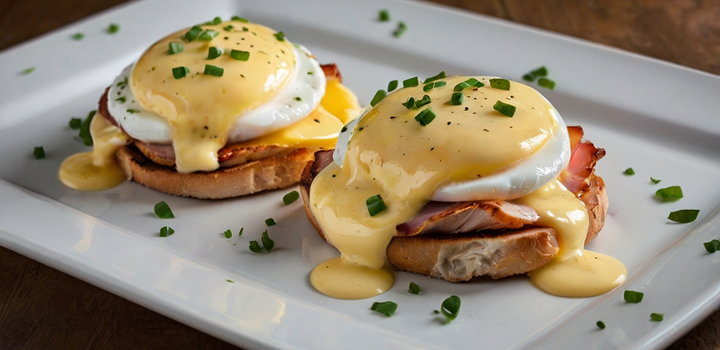
High-Protein Brunch Alternative
I’ve cooked a lot of brunches, and few dishes satisfy the way chicken eggs Benedict does. Swapping traditional ham for chicken transforms the dish into a protein-rich powerhouse—something I appreciate after a morning walk or before a busy weekend. Chicken also gives more room for creativity with seasoning, texture, and portion size. It’s lean, flavorful, and it feels more like a main course than a side component.
Plus, it’s easy to scale. Whether I’m making two servings or feeding six guests, poached eggs and seared chicken portions are manageable even on a tight morning schedule. If I have some prepped meat on hand—like leftovers from Cook Chicken for a Salad—I can get everything on the table in under 20 minutes.
Customized Flavors and Ingredients
The classic Benedict format—protein, egg, bread, sauce—is a canvas. When I make chicken eggs Benedict at home, I tweak it depending on what I have on hand or what I’m in the mood for. Sometimes I lean Southern, with fried chicken and hot sauce hollandaise. Other times, I go light, with grilled breast, Greek yogurt lemon sauce, and sprigs of dill.
It also lets me build around dietary needs. I can toast a gluten-free English muffin, use low-fat yogurt instead of butter-heavy hollandaise, or swap in rotisserie meat for a shortcut. And it always turns out better than anything I’ve had in a crowded café. When I’m cooking chicken in advance for other dishes like Slow Cooked Creamy Chicken Pasta, I often set aside a portion for the next morning’s Benedict.
Essential Ingredient Guide
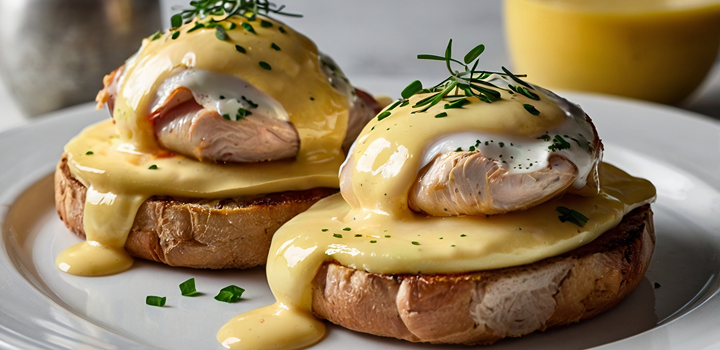
Chicken Choices: Grilled, Rotisserie, or Fried
When it comes to chicken, the preparation changes the entire tone of the dish. Here’s how I decide which version to use:
Lean Grilled Breast
This is my default. I season the chicken simply with salt, pepper, paprika, and a touch of garlic powder. I sear it in a pan or grill it until just cooked through, then slice thin across the grain. The flavor stays clean, letting the poached egg and sauce shine.
This also works well for lighter brunches or when I want a more elegant presentation. It’s very similar in prep to what I use in Chicken breakfast omelet, which keeps the texture soft and juicy without overshadowing the egg.
Rotisserie for Ease
If I’m short on time or don’t want to fuss with raw meat, rotisserie chicken works beautifully. I shred it by hand, warm it gently, and stack it directly onto the bread. It’s especially useful when cooking for guests—I can focus on the eggs and sauce without worrying about timing a fresh protein.
The slight seasoning from rotisserie adds a savory boost, especially when paired with lemony yogurt sauce.
Crispy Fried Chicken Tenders
For indulgent brunches, I go for fried chicken. I use panko or seasoned flour and pan-fry tenders until golden. The contrast between crunchy chicken and soft poached egg is unbeatable. I often serve this with a smoky hollandaise or even a mild hot honey drizzle.
Perfect Poached Eggs Every Time
Water Temperature and Vinegar Tips
I start with a deep saucepan of water, heated to just below a boil—about 190°F (88°C). That’s hot enough to set the egg white quickly without bubbling and breaking the yolk. I always add a splash of white vinegar—around 1 tablespoon per quart of water. It helps the proteins coagulate faster and keeps the whites from drifting apart.
I crack each egg into a ramekin first, then swirl the water with a spoon before gently sliding the egg into the center. The swirling helps wrap the white around the yolk into a tidy shape.
Achieving Firm Whites and Runny Yolks
Timing is everything. For me, 3 minutes and 45 seconds is the sweet spot. I set a timer. Any longer and the yolk starts to thicken. Any shorter and the whites are flimsy. After cooking, I transfer the egg immediately into a bowl of warm—not cold—water, just to rinse off the vinegar and hold it while I finish the rest of the plate.
When I lift the egg with a slotted spoon, I check the white: it should jiggle slightly but not run. The yolk, when pierced, should spill like golden sauce over the chicken and muffin.
Bread Base: English Muffin, Biscuit, or Brioche
The foundation is just as important as what goes on top. English muffins are traditional—and for good reason. Their toasted texture grips the egg and sauce beautifully. I split them with a fork to keep that craggy surface, then toast until deep golden.
Biscuits bring a Southern feel. They’re softer and more buttery, ideal when using crispy fried chicken. I use homemade when I have time, but good-quality frozen biscuits also work if toasted right.
Brioche is my go-to when I want something rich and delicate. Its sweetness balances tart hollandaise and salty chicken. I slice it thick and toast it in butter for a golden crust.
Sauce Options: Traditional Hollandaise vs. Yogurt Version
Traditional hollandaise is luxurious—but finicky. I make mine with three egg yolks, a tablespoon of lemon juice, and about ½ cup of melted butter. I whisk it over a gentle bain-marie, never letting the bowl touch the water directly. When it thickens to a pourable consistency, I season with salt and a pinch of cayenne.
But on lighter days, I go with a yogurt-based sauce. I mix full-fat Greek yogurt with lemon juice, Dijon mustard, and a touch of olive oil. It’s tangy, silky, and far easier to whip up on a weekday morning. It doesn’t overpower the poached egg or chicken, and it holds well even when prepped in advance.
Whether I want indulgent or refreshing, there’s always a way to sauce the Benedict right. And if I’ve got extra sauce left, it often ends up as a dressing for reheated slices of Cook Chicken for a Salad later in the day.
Cooking Techniques for Flawless Benedict
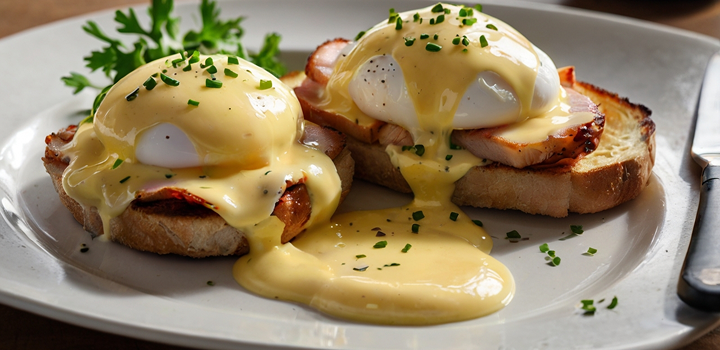
Preparing the Chicken Efficiently
Efficiency in brunch cooking is everything. I start by choosing the right prep method for my chicken based on how much time I have. For grilled or pan-seared breast, I pound the meat slightly for even thickness, season generously, and cook over medium heat until it reaches 165°F (74°C) inside. Then I let it rest for at least 5 minutes before slicing—it stays juicier that way.
If I’m using rotisserie chicken, I warm the shredded meat gently in a skillet with a splash of broth or butter. That brings back moisture without overcooking.
For fried chicken tenders, I season the flour with paprika, garlic powder, salt, and a pinch of cayenne, then dredge the chicken and fry in shallow oil until golden. I drain them on a wire rack, never paper towels, to preserve the crispness.
No matter which version I use, I make sure the chicken is hot and ready before poaching the eggs. The final stack needs everything warm so the yolk can melt through the layers. It’s the same logic I apply when preparing Slow Cooked Creamy Chicken Pasta—stagger your components so nothing sits and cools down before the final plate comes together.
Mastering Poached Eggs
Poaching is about control. I use the freshest eggs possible—older whites spread too much in water. I bring water to a gentle simmer and always swirl it just before adding the egg. If I’m cooking for more than two people, I poach in batches and keep the finished eggs in warm water (120°F / 49°C) to hold until plating.
Once the egg is in, I don’t touch it. I let the water do the work. I’ve tested every shortcut, and nothing beats quiet patience. The result: a compact, runny-centered egg with soft but intact whites.
If I want more insurance, I use a fine mesh strainer to remove the thinner whites before poaching. This trick gives a tighter, restaurant-style shape.
Homemade Hollandaise: Emulsification Engineered
Hollandaise sauce intimidated me when I first started out. Now, I treat it like any other emulsion—time, temperature, and movement. I whisk three yolks with lemon juice over barely simmering water, then slowly drizzle in melted butter while whisking constantly. Once it thickens to a custard-like texture, I season with a pinch of salt and cayenne.
To avoid scrambling the yolks, I lift the bowl off the heat whenever I feel it getting too warm. If it seizes or splits, a teaspoon of hot water whisked in gradually can usually bring it back.
If I want to take the edge off the butteriness, I stir in a touch of Dijon mustard or white wine vinegar. That sharpness balances the richness and plays well with the savory notes of the chicken.
Flavor Variations & Dietary Tweaks
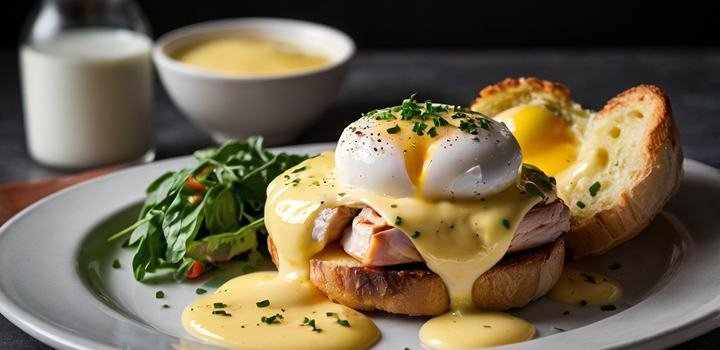
Spicy Nashville-Style Benedict
When I want bold heat and Southern flair, I build a Nashville-style Benedict. I use breaded chicken, then brush it lightly with a hot oil blend—paprika, cayenne, brown sugar, and garlic powder. On top of that, I spoon a smoky hollandaise with chipotle or hot sauce stirred in at the end.
I serve this on a biscuit or thick toast, garnished with pickled jalapeños or sliced scallions. The richness of the yolk cuts the spice perfectly. It’s intense, comforting, and probably my favorite way to impress brunch guests.
It pairs beautifully with simple sides or even layered over leftovers from Chicken breakfast omelet for a spicy brunch sandwich.
Lighter Yogurt Hollandaise Option
If I’m making this on a weekday or want something less rich, I skip the butter emulsion and go with a Greek yogurt base. I mix ½ cup of yogurt with a spoon of Dijon mustard, lemon juice, olive oil, and a pinch of turmeric for color. I warm it gently on the stove, whisking until smooth.
This sauce is bright and light but still adds that creamy tang that binds the egg and chicken together. It also stores better in the fridge, so I can reuse it later in wraps or as a dip.
Gluten-Free & Low-Fat Adaptations
I’ve made this dish dozens of times for friends with dietary needs. For gluten-free diners, I use a sturdy gluten-free English muffin or swap in a slice of polenta, grilled until crisp on the outside.
For lower fat, I go with grilled chicken breast, egg whites instead of whole eggs, and the yogurt sauce. It’s still satisfying but doesn’t feel heavy. And if dairy is the issue, I use lactose-free yogurt or tahini-lemon sauce in place of hollandaise.
This dish, like Cook Chicken for a Salad, is endlessly flexible. With just a few adjustments, I can tailor it to almost any diet or preference—and it never feels like a compromise.
Plating & Presentation Tips
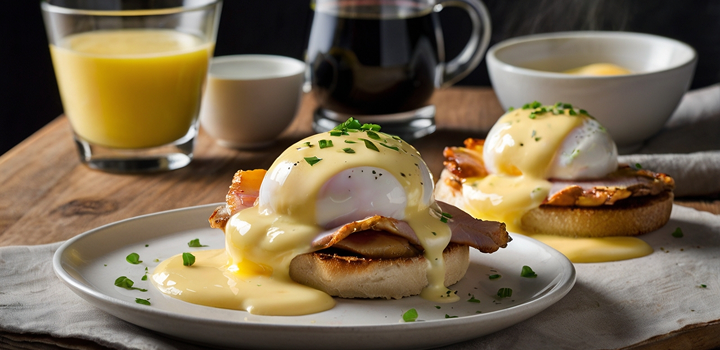
Building a Visually Appealing Stack
When I plate eggs Benedict, I treat it like architecture. I start with a solid, toasted base—English muffin or biscuit—cut cleanly to avoid crumbling. I warm the bread before anything touches it, so it doesn’t cool the rest of the stack.
I layer the chicken next, slightly overlapping thin slices or laying down one compact crispy piece. It’s important the chicken covers the surface without hanging over; otherwise, the egg won’t sit right. If using shredded rotisserie, I shape it gently into a nest to hold the poached egg in place.
The poached egg goes directly on top, centered. I use a slotted spoon, tilt slightly to drain water, and set it down in one motion. The hollandaise comes last, poured slowly from a spoon in a spiral. This gives me full control and avoids flooding the plate.
Garnish and Texture Finishing Touches
A little contrast goes a long way in elevating the final look. I finish the plate with a pinch of smoked paprika or chili flakes on the sauce. If I’m feeling fancy, I add a tiny tuft of microgreens or a sprinkle of finely chopped fresh herbs—chives or dill are my favorites.
A final grind of black pepper or a few toasted breadcrumbs around the edge adds textural interest and crunch. And for something acidic, I plate it with a lemon wedge or a teaspoon of pickled red onion on the side.
In the same way I might dress a finished portion of Slow Cooked Creamy Chicken Pasta with a single herb sprig or shaved cheese, this small touch signals care without adding fuss.
Cooking for a Crowd
Poaching Multiple Eggs Simultaneously
Cooking for six or more? I’ve learned to poach in stages. I set up two medium saucepans side by side, both kept at a gentle simmer with vinegar added. I crack eggs into individual ramekins beforehand. Swirl, drop, repeat—one egg at a time, no crowding.
Once each egg is done, I transfer it into a wide bowl of warm water (about 120°F) where it holds for up to 15 minutes without overcooking. When it’s time to serve, I dip each one in hot water for 10 seconds to reheat, then plate.
If I’m prepping ahead, I even poach eggs up to a day in advance and refrigerate in cold water. Just reheat gently before use. This makes brunch for 10 feel like brunch for 2.
Timing Chicken, Eggs, and Sauce Together
I always start with the sauce. Hollandaise needs to be warm but not hot, so I make it first and keep it over a barely warm water bath.
While the sauce holds, I cook the chicken—grilled or fried—then keep it tented under foil in a warm oven (around 200°F). Eggs come last, since poaching is quick and best done just before serving.
I line up the muffins or biscuits, have all toppings and garnishes ready, and work down the line, assembling each portion as soon as the egg is done. With practice, I can plate six full Benedicts in under 5 minutes. Brunch service, minus the stress.
15+ Frequently Asked Questions
1. Can I use leftover chicken in eggs Benedict?
Yes, rotisserie or any cooked chicken works great. Just reheat it gently with broth or butter to keep it moist before stacking.
2. What’s the easiest sauce if I don’t want to make hollandaise?
Try a warm yogurt sauce: mix Greek yogurt with lemon, Dijon mustard, and olive oil. It’s tangy and creamy, no double boiler needed.
3. How can I poach eggs without them falling apart?
Use fresh eggs, add a splash of vinegar to simmering water, and swirl before adding each egg. Strain off watery whites first for best results.
4. Is there a gluten-free option for the bread?
Yes, use gluten-free English muffins, cornmeal cakes, or even grilled polenta rounds as a sturdy base.
5. Can I make the whole dish ahead?
You can prep the chicken, poach eggs ahead and chill them, and make the sauce. Reheat gently and assemble just before serving.
6. Can I use fried eggs instead of poached?
You can, but you’ll miss that runny yolk that binds the dish. Sunny-side up is a good compromise if poaching feels too advanced.
7. What other proteins work instead of chicken?
Turkey, ham, smoked salmon, or even a meatless patty can all work in the same format. The key is balance with egg and sauce.
8. Is hollandaise safe to eat if made with raw eggs?
Yes, the yolks are gently cooked over a water bath. Use pasteurized eggs if concerned.
9. How do I stop hollandaise from splitting?
Control the heat, whisk constantly, and don’t add butter too fast. If it splits, whisk in a little hot water or another yolk to fix it.
10. What vegetables can I add to this dish?
Wilted spinach, avocado slices, sautéed mushrooms, or grilled asparagus pair beautifully without overpowering the main layers.
11. Can I freeze eggs Benedict?
Not recommended. Poached eggs and hollandaise don’t hold up well to freezing or reheating.
12. What cheese pairs well with this dish?
Mild cheeses like Havarti or soft goat cheese can be added between chicken and egg for extra richness.
13. Can I make it spicy?
Yes, add chili flakes, hot sauce in the hollandaise, or use spicy fried chicken like in a Nashville twist.
14. What if I don’t eat dairy?
Use dairy-free butter or yogurt for sauce, and check that your muffin or biscuit is dairy-free too.
15. How do I serve this dish elegantly?
Use small plates, garnish neatly, and serve immediately while all layers are hot and the yolk flows beautifully when cut.
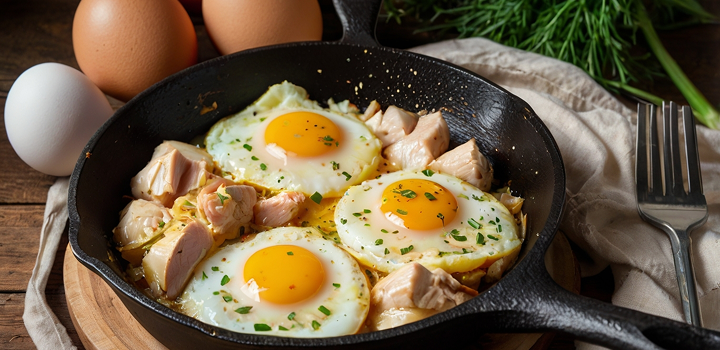
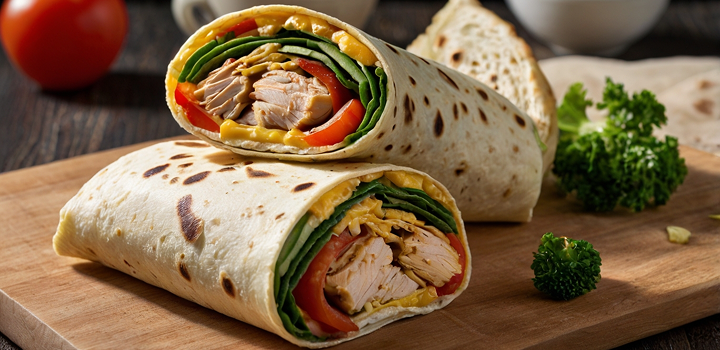
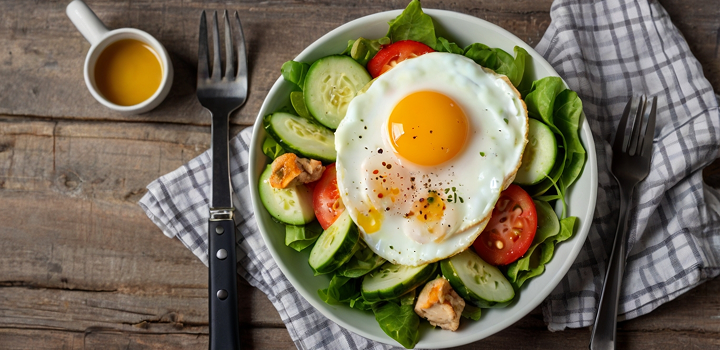
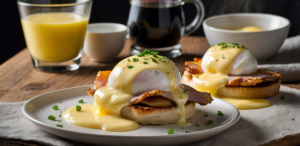
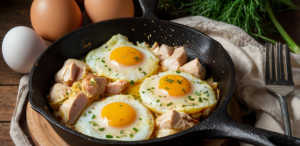
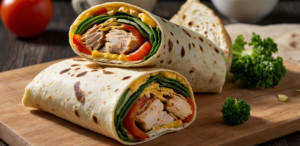
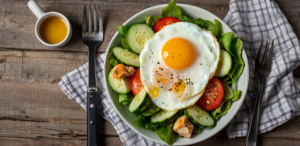
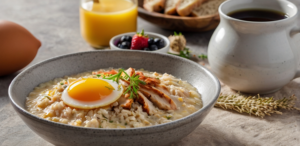
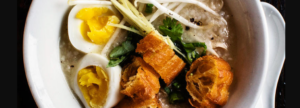

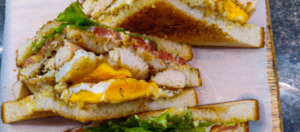
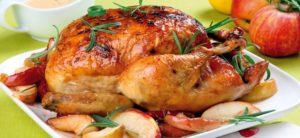
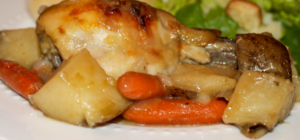
Post Comment